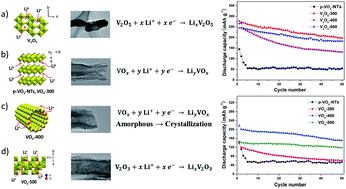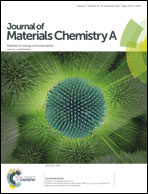Annealed vanadium oxide nanowires and nanotubes as high performance cathode materials for lithium ion batteries
Abstract
Low electron transportation and lithium ion diffusion coefficient in laminar vanadium oxide nanostructures limit their electrochemical performance for lithium ion batteries. In this work, V2O5 nanowires and VOx nanotubes were obtained via heat treatment of the pristine vanadium oxide nanotubes at different temperatures under air and nitrogen atmospheres, respectively, and then used as cathode materials for lithium ion batteries. It is interesting to note that the pristine vanadium nanotubes were transformed to V2O5 nanowires under an ambient atmosphere while the nanotube morphology can be maintained under an inert N2 atmosphere. The electrochemical results show that the V2O5 nanowires obtained at 400 °C deliver the best cycling performance with an initial discharge capacity as high as 278 mA h g−1 and the best rate capability with a discharge capacity of 115 mA h g−1 at 500 mA g−1. The VOx nanotubes obtained at 400 °C show the highest lithium storage capacity of 218 mA h g−1 with excellent capability retention and the best rate capability among all the nanotube samples. The improvement of electrochemical properties of V2O5 nanowires and VOx nanotubes can be attributed to the synergy of the enhanced surface area and better crystallinity. The different electrochemical properties reveal the existence of four different modes of Li ion intercalation/de-intercalation behaviors in V2O5 nanowires and VOx nanotubes. It is very interesting to note that the Li ion intercalation/de-intercalation in amorphous VOx nanotubes (VOx + yLi+ + ye− → LiyVOx) can induce a phase transformation from amorphous matrix to layered crystalline structure. This present work reveals that the electrochemical properties, in particular the cycling stability of vanadium oxide nanostructures, can be improved by tuning the one-dimensional structures' crystallinity. Furthermore, the phase transformation from amorphous matrix to layered crystalline structure of VOx nanotubes may open an exciting door for all the amorphous nanostructures for the application of LIBs.


 Please wait while we load your content...
Please wait while we load your content...